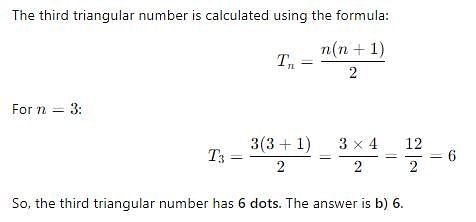Class 6 Exam > Class 6 Tests > Mathematics (Maths) Class 6 > Test: Patterns in Mathematics - 2 - Class 6 MCQ
Test: Patterns in Mathematics - 2 - Class 6 MCQ
Test Description
10 Questions MCQ Test Mathematics (Maths) Class 6 - Test: Patterns in Mathematics - 2
Test: Patterns in Mathematics - 2 for Class 6 2024 is part of Mathematics (Maths) Class 6 preparation. The Test: Patterns in Mathematics - 2 questions and answers have been
prepared according to the Class 6 exam syllabus.The Test: Patterns in Mathematics - 2 MCQs are made for Class 6 2024 Exam. Find important
definitions, questions, notes, meanings, examples, exercises, MCQs and online tests for Test: Patterns in Mathematics - 2 below.
Solutions of Test: Patterns in Mathematics - 2 questions in English are available as part of our Mathematics (Maths) Class 6 for Class 6 & Test: Patterns in Mathematics - 2 solutions in
Hindi for Mathematics (Maths) Class 6 course. Download more important topics, notes, lectures and mock
test series for Class 6 Exam by signing up for free. Attempt Test: Patterns in Mathematics - 2 | 10 questions in 15 minutes | Mock test for Class 6 preparation | Free important questions MCQ to study Mathematics (Maths) Class 6 for Class 6 Exam | Download free PDF with solutions
Detailed Solution for Test: Patterns in Mathematics - 2 - Question 1
Detailed Solution for Test: Patterns in Mathematics - 2 - Question 2
| 1 Crore+ students have signed up on EduRev. Have you? Download the App |
Test: Patterns in Mathematics - 2 - Question 3
How many dots are in the third triangular number?
Detailed Solution for Test: Patterns in Mathematics - 2 - Question 3
Test: Patterns in Mathematics - 2 - Question 4
If you start with the number 2 and keep adding 2, what sequence are you creating?
Detailed Solution for Test: Patterns in Mathematics - 2 - Question 4
Detailed Solution for Test: Patterns in Mathematics - 2 - Question 5
Test: Patterns in Mathematics - 2 - Question 6
Which of the following shapes is a three-dimensional object?
Detailed Solution for Test: Patterns in Mathematics - 2 - Question 6
Test: Patterns in Mathematics - 2 - Question 7
Which sequence of numbers represents the number of sides in regular polygons?
Detailed Solution for Test: Patterns in Mathematics - 2 - Question 7
Test: Patterns in Mathematics - 2 - Question 8
Which of the following number sequences is related to triangular numbers?
Detailed Solution for Test: Patterns in Mathematics - 2 - Question 8
Test: Patterns in Mathematics - 2 - Question 9
Which number is both a square and a triangular number?
Detailed Solution for Test: Patterns in Mathematics - 2 - Question 9
Test: Patterns in Mathematics - 2 - Question 10
What do regular polygons and number sequences have in common?
Detailed Solution for Test: Patterns in Mathematics - 2 - Question 10
|
94 videos|347 docs|54 tests
|
Information about Test: Patterns in Mathematics - 2 Page
In this test you can find the Exam questions for Test: Patterns in Mathematics - 2 solved & explained in the simplest way possible.
Besides giving Questions and answers for Test: Patterns in Mathematics - 2, EduRev gives you an ample number of Online tests for practice
|
94 videos|347 docs|54 tests
|
Download as PDF


















